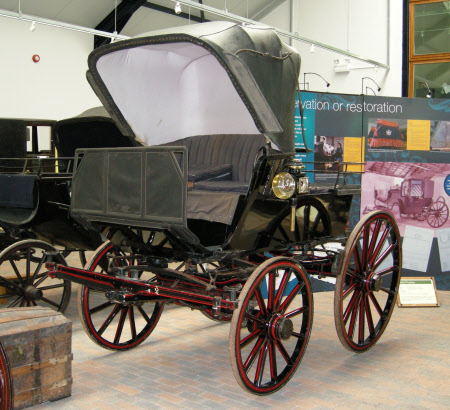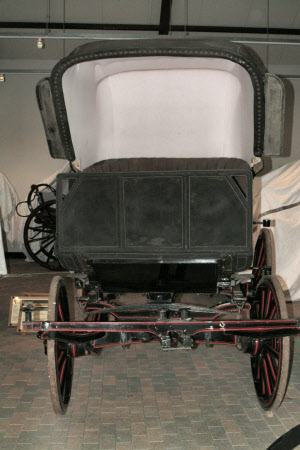Mail phaeton
Holland and Holland
Category
Carriages & other vehicles
Date
1840
Materials
Painted wood body with leather hood, wool cloth upholstery and four iron shod wheels.
Measurements
254 x 266.5 x 176cm (8ft 4in x 8ft 9in x 5ft 9 1/4in)
Place of origin
London
Order this imageCollection
National Trust Carriage Museum
NT 272888.1
Caption
The mail phaeton was considered the undoubted head of the phaeton family and, because of its size and its style, was the ideal carriage for a country sportsman to drive his own horses. It is called a mail phaeton because the springs are similar to those of a mail coach. These carriages were always driven by the owner, the principal seat therefore being the only one with any form of protection from the weather.
Summary
Mail Phaeton built by Holland & Holland circa 1840. Mail Phaeton (four wheels) for a pair or team of horses. This carriage has a centre pole and is sprung on telegraph springs, there is a leatherette hood. The interior is upholstered in dark blue with three cushions this has faded badly and now appears brown in colour. Painted in black livery with red lining.
Full description
Built by Holland and Holland, London, a premier builder of sporting carriages, probably in the mid 1800s, this mail phaeton was donated by Sir Dymoke White of Havant, Hampshire. Mail phaetons were owner-driven to two or four horses with one or two grooms, and could carry one passenger in addition to the driver. A phaeton is a four-wheeled carriage that was driven by the owner, and never by his professional coachman, so the principal seat is always in front, with a seat for a groom, or in this case two grooms, behind. The mail phaeton was considered the undoubted head of the phaeton family and, because of its size and its style, was the ideal carriage for a country sportsman to drive his coach horses as a pair or a team, if the occasion did not justify the use of his drag. It is called a mail phaeton because the springs are similar to those of a mail coach. Mail phaetons were occasionally postillion-driven for travelling, but were principally used by sportsmen who enjoyed driving their own horses.
Marks and inscriptions
On front nearside axle components.: A On front offside axle components.: A On rear nearside axle components.: A On rear offside axle components.: A On beam at front of groom’s footwell.: Holland & Holland On nearside lamp on the candle holder caps.: GUDDON BUNGAY On offside lamp on the candle holder caps.: GUDDON BUNGAY
Makers and roles
Holland and Holland, coach builder


